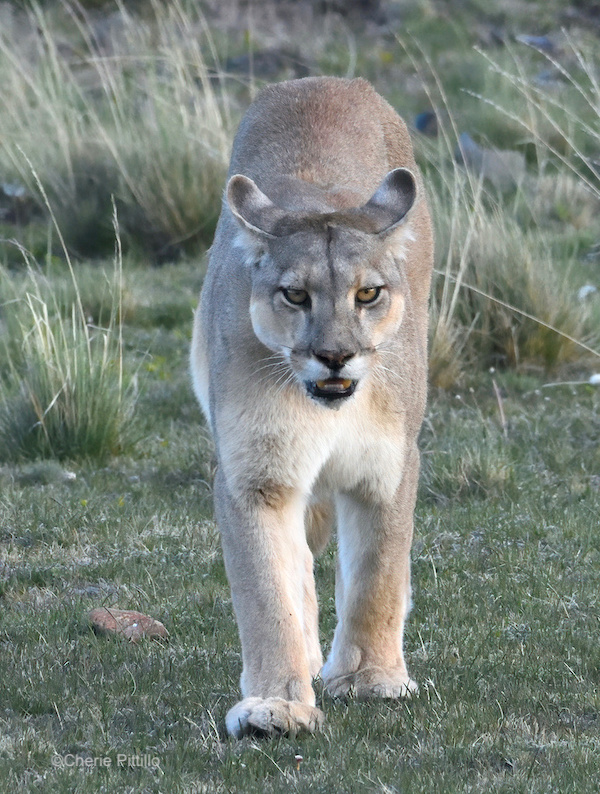Welcome to my personal puma path, an addendum on where and how to find pumas to photograph.
Part 1 introduced common misconceptions and misrepresentations of the mountain lion or puma.
Part 2 illustrated a few common characteristics of these cats.
Patagonia, Chile is the Mecca for wild puma photography as it is absolutely the best place in the Americas! Torres del Paine National Park (torres Spanish for towers, and paine indigenous for blue) and adjacent sheep ranches offer the pumas protection in more than half a million acres of diverse habitats. Photographers can choose to photograph on sheep ranches with certified puma trekkers to obtain closer proximity to habituated, wild pumas or enjoy the national park. Either way, the magnificent vistas await wherever you are in this region whether the pumas are visible or not!
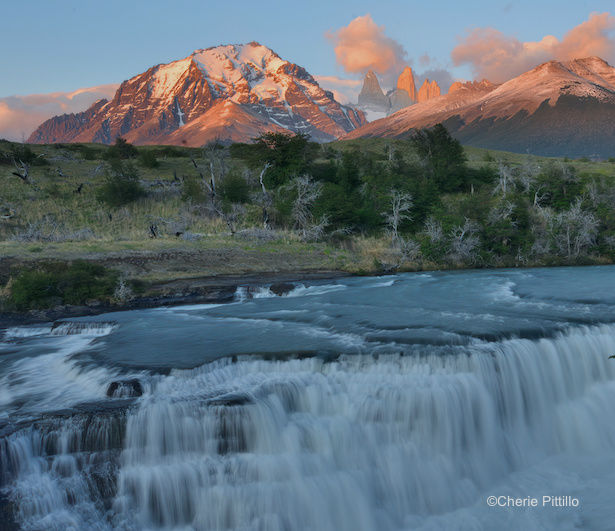
Since 1980, pumas were protected by the Chilean government, but 100% of all sheep ranchers killed them until one ranch decided to explore eco-tourism to observe and photograph pumas. In 1995, this ranch had lost 80% of their sheep in a blizzard called a white earthquake. Ten years later a fire destroyed 10,000 acres. In essence saving pumas saved this ranch located adjacent to the national park. That ecotourist endeavor influenced other ranchers to protect these cats. However, not all ranchers concurred and continue to kill them.
The typical habitat of this ranch is termed Patagonian steppe which is a dry climate with sandy soil, low bushes and shrubs, little rain, and strong, harsh winds.

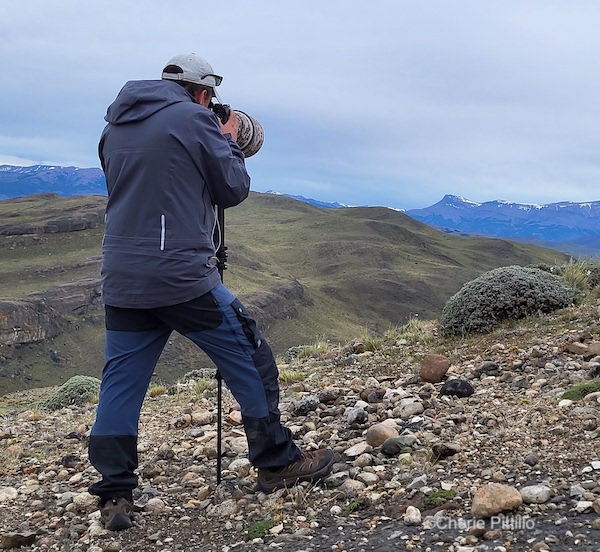
HOW DID YOU FIND A PUMA IN THOUSANDS OF ACRES
ON A SHEEP RANCH?
WE USED SIX METHODS.
But first, standardized rules were reviewed by a certified puma trekker (tracker) before you even looked for pumas. You couldn’t interfere with the puma’s behavior. You never chased the cat nor cut it off from where it traveled. You were permitted to walk parallel to the cat and to photograph from a great distance away. If the puma ran up a hill, you were permitted to run or walk faster, but you couldn’t actually chase the cat. Sometimes you could get ahead of the cat to hope it would eventually walk or run within camera range. If one approached you, you quietly froze.
You got up at 4 AM and departed at 4:30 AM to take advantage of riding in a 4X4 SUV on unimproved dirt roads (REALLY ROUGH), to get closer to the puma once it was found by a puma trekker instead of hiking many miles. We usually returned to our hotel by noon for lunch and then out again at 4:30 PM until 10 PM for dinner.
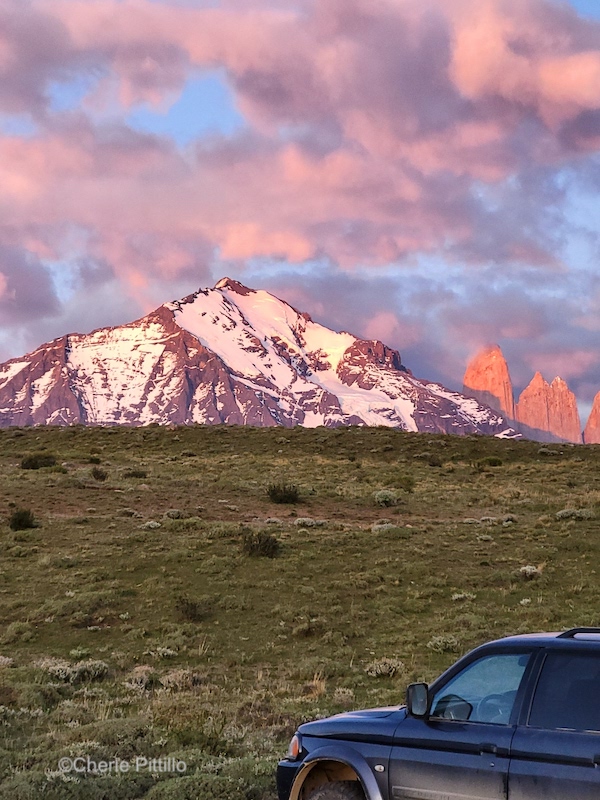
METHOD 1: Our photo leader hired three trekkers. One left earlier and then radio communicated with each of the two other trekkers driving the two vehicles. Junior was the early scout on foot to search for the cats to transmit sightings with our two other trackers who each drove a vehicle.
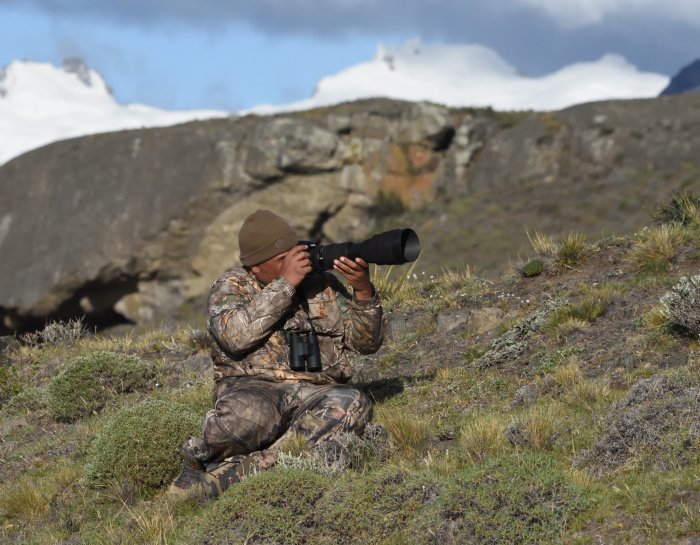
METHOD 2: Naun owned the company and used binoculars to search, a method called glassing.

METHOD 3: Javi, who was the first female certified puma trekker in South America, waited patiently for a puma to return to a carcass. She also searched on foot and also used binocs. Note she carries backpack, phone, radio, binoculars, and camera. These three had worked with pumas and jaguars for seven years in Brazil and now had seven years with the pumas in Chile.
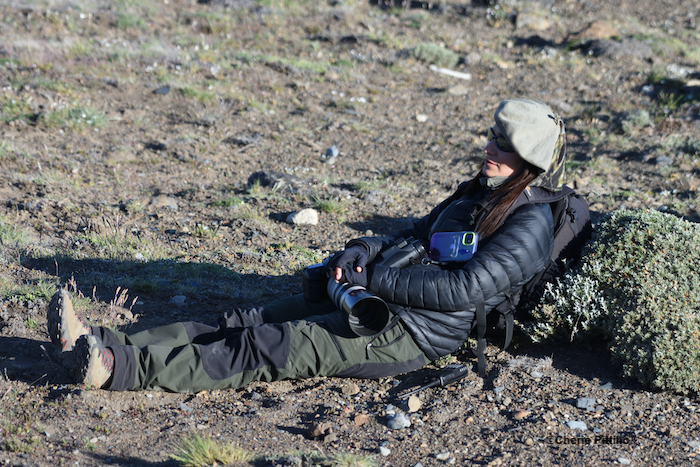

METHOD 4: An easier method for the trekkers involved hearing a guanaco alarm call for a predator. A sentry stands guard while the herd eats with lowered heads. The guanaco, the llama ancestor, stands six feet tall, weighs up to 250 pounds, and is the main puma prey.
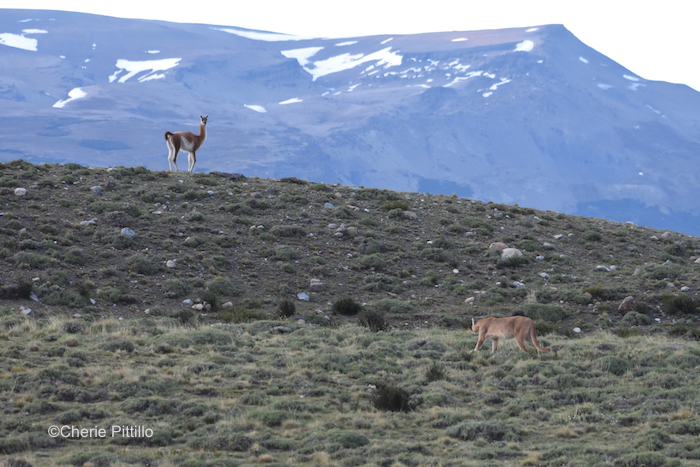
LINK TO CALL https://search.macaulaylibrary.org/catalog?taxonCode=t-11066186&searchField=animals

METHOD 5: Trekkers watched the sky for scavenging Andean Condors. Studies indicate that these large birds can scare off a puma from its prey so that the puma has to increase its kill rate by 50%. But we didn’t need this method as we only saw 4 condors soaring and never at a kill in five days with the pumas.
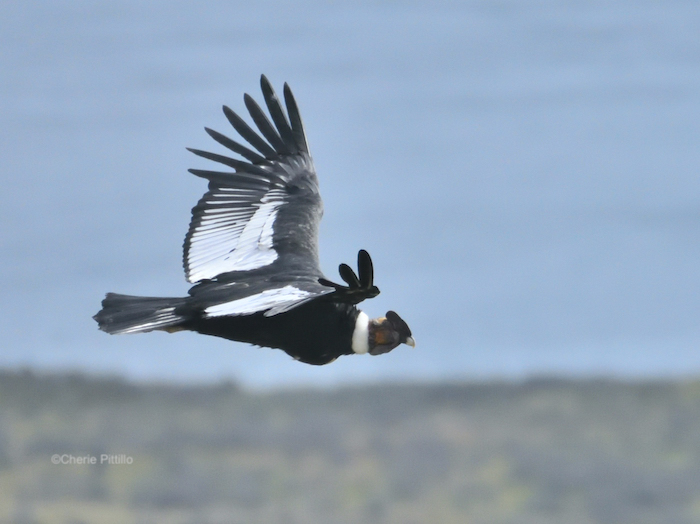
METHOD SIX: The easiest. The pumas approach a water hole adjacent to a main highway and we happen to drive by. By the way only three times in five days did we have other photographers join us.
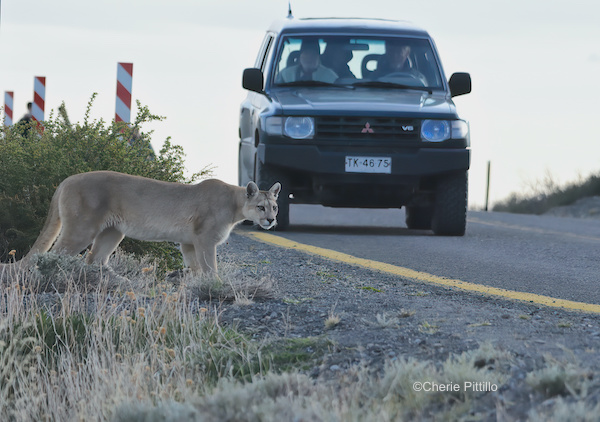
I would be remiss if I didn’t discuss the danger of trying to kill prey that is larger and heavier than a puma. I don’t know how this puma was injured but we did see a mom with two cubs who limped so badly she could barely walk. Plus both males and females will fight to defend their territories.
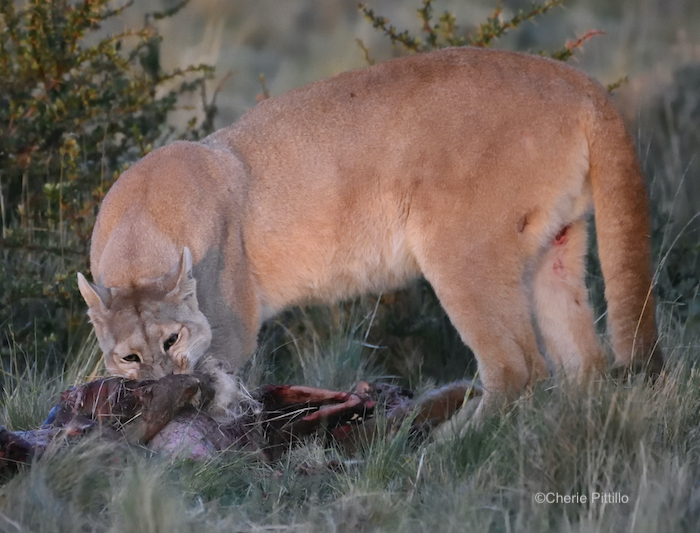
HOW CLOSE?
This female adult puma walked within three feet of our photography group which included at that moment one puma trekker and our master photography leader with us five photographers. She even sniffed a camera bag on the ground. Note the two photographers with lenses down in the background. And please remember, humans were/are not prey. The cats were well aware we were there and basically ignored us.
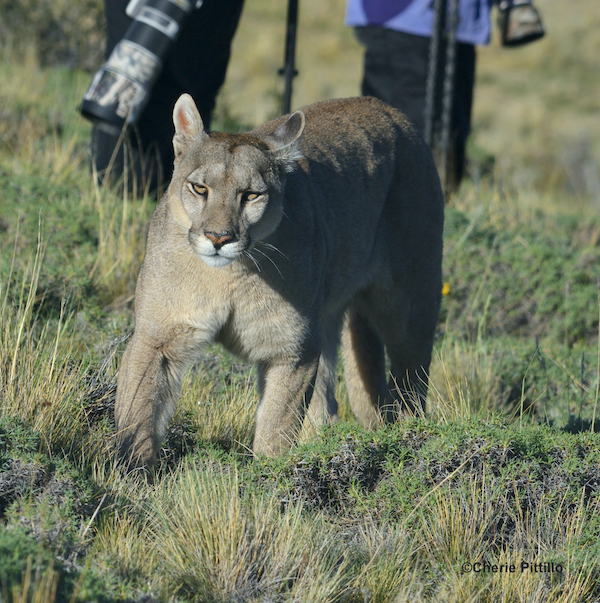
HOW TO IDENTIFY A PUMA NOT WEARING A COLLAR
In our puma trekkers seven years, 70 different pumas had been identified in this area. They named adult cats for ease in identification and communication and wouldn’t name the cubs until one year of age. Most cubs don’t survive that first year.
Puma identification involved looking at scars on the nose and lips, nose color, and even whisker patterns.

However, while our group descended a hill, our photo leader almost stepped on a puma in a small bushy area which immediately crouched down trying to hide, not attack. Our leader bypassed it and then the cat crept away and ran from its hiding place. None of the trackers had seen this animal so that was #71.
Now it’s time to “high tail” it out of the addendum!
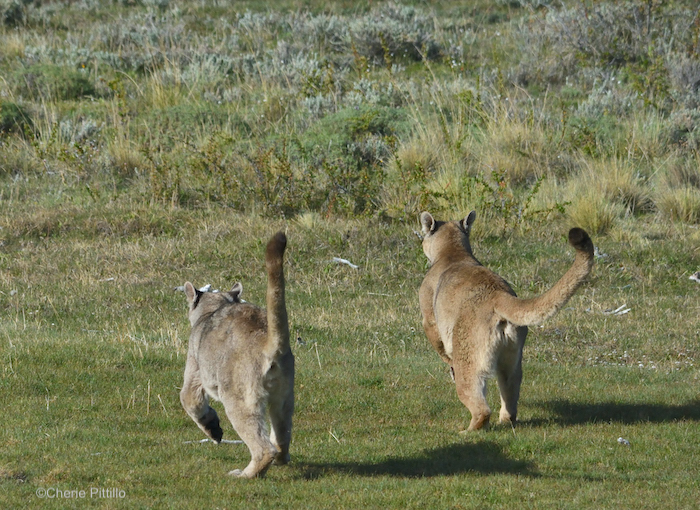
AUTHOR’S NOTE: AN INCREDIBLE LIFE HIGHLIGHT!
As a young child my Granny talked about “painters,” a common name in the North Carolina mountains for a mountain lion. Always intrigued about this mysterious cat, I even found a cougar-less den during a vacation in the Grand Tetons, Wyoming. I’d heard about puma trekking in Patagonia, Chile from Yucatecan friend, Alex Dzib, but never thought I would be able to hike miles in the Andes to see them.
For a routine open heart surgery in 2015, I’d attached a giant poster on my hospital door with my goal not knowing then some major health issues would creep into my future:
Unbeknownst to science, my body healed, I found an incredible, master photo leader named Hector Astorga, based in Mission, TX, who took away those long miles of hiking in the lower hills of the Andes with that trekking team. We only hiked 2-4 miles a day, but I also carried heavy camera gear, dressed for the cold, and always worked against the strong wind. It was exhausting physically and mentally and I wouldn’t change a thing.
And now you know the rest of the story.
Thank you for allowing me to share this very personal puma path!
Never say never. My dream came true in November, 2022.
PART 1 link
PART 2 link
REFERENCE: Macaulaylibrary.org
Cherie Pittillo, “nature inspired,” photographer and author, explores nature everywhere she goes. She’s identified 56 bird species in her Merida, Yucatan backyard view. Her monthly column features anecdotes about birding in Merida, Yucatan and also wildlife beyond the Yucatan.
Contact: [email protected] All rights reserved, ©Cherie Pittillo

